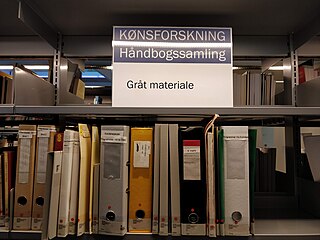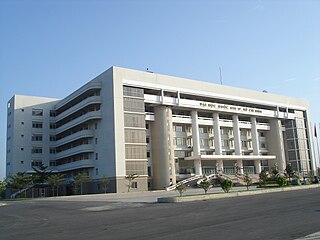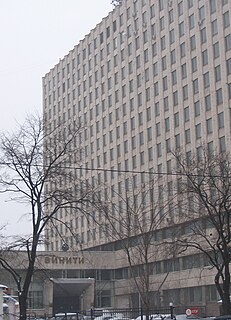Related Research Articles

The International Atomic Energy Agency (IAEA) is an international organization that seeks to promote the peaceful use of nuclear energy, and to inhibit its use for any military purpose, including nuclear weapons. The IAEA was established as an autonomous organization on 29 July 1957. Though established independently of the United Nations through its own international treaty, the IAEA Statute, the IAEA reports to both the United Nations General Assembly and Security Council.

ProQuest LLC is an Ann Arbor, Michigan-based global information-content and technology company, founded in 1938 as University Microfilms by Eugene B. Power. ProQuest is known for its applications and information services for libraries, providing access to dissertations, theses, ebooks, newspapers, periodicals, historical collections, governmental archives, cultural archives, and other aggregated databases. This content was estimated to be around 125 billion digital pages, and is commonly accessed through library Internet gateways. This includes tools for discovery and citation management, and platforms that allow library users to search, manage, use, and share research.

Scientific literature comprises scholarly publications that report original empirical and theoretical work in the natural and social sciences. Within an academic field, scientific literature is often referred to as the literature. Academic publishing is the process of contributing the results of one's research into the literature, which often requires a peer-review process.
The LANL Research Library is a research library at Los Alamos National Laboratory. It contains a substantial collection of books, journals, databases, patents along with technical reports. Additionally it offers literature searching, training, and outreach services. The library has a research and development (R&D) component, which works in areas such as open archives, recommendation systems, emergency response information systems, and discovery systems. Its stated mission is to deliver effective and responsive knowledge services, thereby connecting people with information, technology, and resources. Its stated purpose (vision) is essential knowledge services for national security sciences.

Chemical Abstracts Service (CAS) is a division of the American Chemical Society. It is a source of chemical information. CAS is located in Columbus, Ohio, United States.

The Office of Scientific and Technical Information (OSTI) is a component of the Office of Science within the U.S. Department of Energy (DOE). The Energy Policy Act PL 109–58, Section 982, called out the responsibility of OSTI: "The Secretary, through the Office of Scientific and Technical Information, shall maintain with the Department publicly available collections of scientific and technical information resulting from research, development, demonstration, and commercial applications activities supported by the Department."

Grey literature is materials and research produced by organizations outside of the traditional commercial or academic publishing and distribution channels. Common grey literature publication types include reports, working papers, government documents, white papers and evaluations. Organizations that produce grey literature include government departments and agencies, civil society or non-governmental organizations, academic centres and departments, and private companies and consultants.
CSA was a division of Cambridge Information Group and provider of online databases, based in Bethesda, Maryland before merging with ProQuest of Ann Arbor, Michigan in 2007. CSA hosted databases of abstracts and developed taxonomic indexing of scholarly articles. These databases were hosted on the CSA Illumina platform and were available alongside add-on products like CSA Illustrata. The company produced numerous bibliographic databases in different fields of the arts and humanities, natural and social sciences, and technology. Thus, coverage included materials science, environmental sciences and pollution management, biological sciences, aquatic sciences and fisheries, biotechnology, engineering, computer science, sociology, linguistics, and other areas.

Viet Nam National University Ho Chi Minh City is one of the two largest national research universities in Vietnam, founded on 27 January 1995, and reorganized on 12 February 2001, under the Decision no. 15/2001/QĐ-TTg by the Prime Minister of Vietnam Phan Văn Khải. The university now provides undergraduate and graduate education to 56,427 students, including:
FIZ Karlsruhe — Leibniz Institute for Information Infrastructure, formerly Fachinformationszentrum Karlsruhe, is a not-for-profit company with the public mission to make sci-tech information from all over the world publicly available and to provide related services in order to support the national and international transfer of knowledge and the promotion of innovation. The service institution is member of Gottfried Wilhelm Leibniz Scientific Community, a union of German research institutes. The institute provides information services and infrastructure for the academic and research community and maintains a collection of scientific databases.
Inspec is a major indexing database of scientific and technical literature, published by the Institution of Engineering and Technology (IET), and formerly by the Institution of Electrical Engineers (IEE), one of the IET's forerunners.
The Energy Citations Database (ECD) was created in 2001 in order to make scientific literature citations, and electronic documents, publicly accessible from U.S. Department of Energy (DOE), and its predecessor agencies, at no cost to the user. This database also contains all the unclassified materials from Energy Research Abstracts. Classified materials are not available to the public. ECD does include the unclassified, unlimited distribution scientific and technical reports from the Department of Energy and its predecessor agencies, the Atomic Energy Commission and the Energy Research and Development Administration. The database is usually updated twice per week.
VINITI Database RAS is a database provided by the All-Russian Institute for Scientific and Technical Information (VINITI). The database is devoted to scientific publications. It is described as a large abstracting database. In general, it is indexed for the natural sciences, exact sciences, and technical sciences. Included in this database is AJ, indexed from 1981 to the present day.

The Energy Technology Data Exchange (ETDE) was formed in 1987 and officially ended 30 June 2014. It was initiated as a multilateral agreement under the International Energy Agency (IEA) agreement network, replacing numerous other bilateral agreements. The multilateral agreement was for the international exchange of energy research and development and information. The exchange resulted in a database which was the world's largest collection of energy research, technology, and development (RTD) information. The collection of information was generated from energy RTD literature published in member countries and through other partnering arrangements with organizations such as the International Nuclear Information System. This had the effect of creating a broad spectrum of information that was included in the ETDE database. The range of content included fossil fuels, renewable energies, End-Use, fusion, energy policy, conservation, and efficiency, and cross-sectional activities. This fulfilled the need for timely exchange of global information towards the goal of a sustainable energy future. ETDE operated under an IEA Implementing Agreement and was governed by an Executive Committee of delegates from ETDE member countries. Officers of the Executive Committee included a Chair and two Vice-Chairs, elected to three-year terms. Day-to-day operations were managed through an operating agent organization, which reported to the Executive Committee.

VINITI is a subsidiary of the Russian Academy of Sciences devoted to gathering scientific and technical information from sources throughout the world and disseminating this information to Russian scientific community.
CAB Direct is a source of references for the applied life sciences It incorporates two bibliographic databases: CAB Abstracts and Global Health. CAB Direct is an access point for multiple bibliographic databases produced by CABI. This database contains 8.8 million bibliographic records, which includes 85,000 full text articles. It also includes noteworthy literature reviews. News articles and reports are also part of this combined database.
The Information Bridge: Department of Energy Scientific and Technical Information database provides free public access to over 298,000 full-text electronic documents of Department of Energy (DOE) research report literature. See list of academic databases and search engines.

The German National Library of Science and Technology, abbreviated TIB, is the national library of the Federal Republic of Germany for all fields of engineering, technology, and the natural sciences. It is jointly funded by the Federal Ministry of Education and Research (BMBF) and the 16 German states. Founded in 1959, the library operates in conjunction with the Leibniz Universität Hannover. In addition to acquiring scientific literature, it also conducts applied research in such areas as the archiving of non-textual materials, data visualization and the future Internet. The library is also involved in a number of open access initiatives. With a collection of over 9 million items in 2017, the TIB is the largest science and technology library in the world.
Chaitanyamoy Ganguly is an Indian nuclear scientist and a former head of the Nuclear Fuel Cycle and Materials Section of the International Atomic Energy Agency (IAEA), credited with many innovations in the field of nuclear material science. He was honored by the Government of India, in 2002, with the fourth highest Indian civilian award of Padma Shri.
Science and technology is Jordan's fastest-growing economic sector. This growth is occurring across multiple industries, including information and communications technology (ICTs), solar and wind energy and nuclear technology.
References
- 1 2 3 4 EDB (2010). "What is the Energy Science and Technology Database?". U.S. Department of Commerce. Archived from the original (National Technical Information Service) on 2010-05-27. Retrieved 1 June 2010.
- ↑ Dialog Bluesheets (June 1, 2010). "Energy Science and Technology". Dialog, LLC. Retrieved 2010-06-29.
![]() This article incorporates public domain material from websites or documents ofthe United States Government .(Dept. of Commerce)
This article incorporates public domain material from websites or documents ofthe United States Government .(Dept. of Commerce)